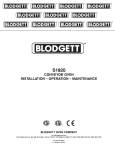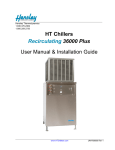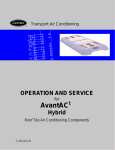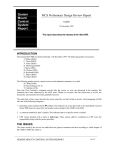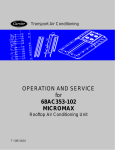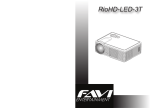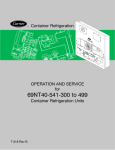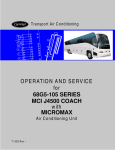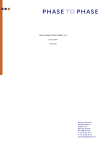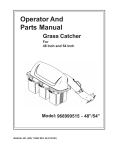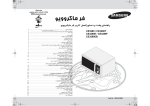Download Operation Manual
Transcript
Operation Manual AvantAC Classic Bus Air Conditioning Units Carrier Transicold China 1235 201821 86-21-59166868 86-21-59165013 Headquarter: No.1235 Ye Cheng Rd. Jiading District, Shanghai, 201821, China Tel: 86-21-59166868 Fax: 86-21-59165013 60 200434 86-21-65923817 86-21-65923827 Service Centre: No.60 Guang Yue Rd. Shanghai, 200434, China Tel: 86-21-65923817 Fax: 86-21-65923827 77-66892-00 Rev. - CSDD ................................................................................................... 2 ................................................................................................... 3 / ............................................................................... 4 1.1 ........................................................................ 4 1.2 ........................................................................... 4 1.3 ........................................................................... 4 ....................................................... 5 1.4 ........................................................................................... 6 ........................................................... 7 2.1 2.1.1 / ................................................................. 7 2.1.2 .............................................. 7 2.1.3 .......................................... 8 2.2 ........................................................................ 8 2.3 ............................................................................ 8 2.3.1 ...................................................................... 8 2.3.2 .............................................. 9 2.3.3 .................................................................. 9 2.3.4 .......................................................................... 10 2.3.5 .................................................................. 10 2.3.6 ..................................................................10 2.3.7 ..................................................................11 ..................................................................11 2.3.8 ...........................................................................................12 ............................................................................12 3.1 3.2 / ................................................................12 ........................................................................13 3.3 ...................................................................................................14 1 2 3 1.1 1.2 1.3 1.3 1.4 / 1-1 4 5 2.1 2.1.1 1 6 2 5 / 2.1.2 + 7 3 8 4 9 1 1 10 2-1 / 1 6 + 7 2 3 8 / 4 9 5 10 1-5 20% 40% 60% 80% 100% + 10 10 3 6 7 2.1.3 2.3.2 a. b. ( )-7 c. ( d. )-8 18 / ( 2 )-9 e. ( f. ( ( ) ) - 10 2.3.3 )-7 8 2.2 0.5 10-15 a. b. 0.5 c. d. 2 2.3 2.3.1 8 9 28 2.3.4 2.3.7 6 20% 40% 60% 80% 100% 2.3.8 2.3.5 3 2 2.3.6 i 22 10 o 19 i -- 10 o -- 11 3.1 3.3 a. b. 3.2 c. d. e. 12 13 A P 3 5 B Q 12 9 C OPERATION MANUAL S 8 4 D X 4 12 4 G 8 4 5 H Y 5 4 J 5 4 6 8 Z 4 5 2 / K 12 3, 4 4 L 4 14 BUS AIR CONDITIONING UNITS AvantAC Classic with CSDD Controller Contents Introduction .............................................................................................................. 18 Safety ......................................................................................................................... 19 Unit/System Information ........................................................................................ 20 1.1 What is Air Conditioning .............................................................................. 20 1.2 Air Conditioning System .............................................................................. 20 1.3 System Componebts ................................................................................... 20 1.4 Model And Serial Number Tags .................................................................. 21 Unit Operation .......................................................................................................... 22 2.1 Driver Display Functions .............................................................................. 23 2.1.1 Key Functions, Engine On .................................................................. 23 2.1.2 Led Functions, Engine On .................................................................. 23 2.2 Pre-trip Inspection ........................................................................................ 24 2.3 Operating Instructions ................................................................................. 24 2.3.1 Display .................................................................................................. 24 2.3.2 Starting And Interior Temperature Control ........................................ 24 2.3.3 Automatic Climate Control .................................................................. 24 2.3.4 Vent ...................................................................................................... 25 2.3.5 Manual Reheat ................................................................................... 25 2.3.6 Temperature Indication ........................................................................ 26 2.3.7 Dry Heat Mode .................................................................................... 26 2.3.8 Eco Mode ............................................................................................. 26 System Maintenance .............................................................................................. 27 3.1 Warranty/service ........................................................................................... 27 3.2 Maintenance Schedule ................................................................................ 28 Index ........................................................................................................................... 29 17 Safety Introduction AvantAC Classic Operation Manual This guide has been prepared for the operator of Carrier Transport Air Conditioning systems. It contains basic instructions for the daily operation of the air conditioning system as well as safety information, and other information that will help you to maintain a comfort level for your self and your passengers. Please take the time to read the information contained in this booklet and refer to it whenever you have a question about the operation of your Carrier Transport Air Conditioning system. More comprehensive information can be found in the AvantAC Operation and Service Manual. This manual can be obtained from your Carrier Transport A/C dealer. Your air conditioning system has been engineered to provide long, trouble-free performance when it is properly operated and maintained. A comprehensive maintenance program will help to insure that the unit continues to operate reliably. Such a maintenance program will also help to control operating costs, increase the unit's working life, and improve performance. Some Vehicles may require information from manuals supplied by the vehicle manufacturer or other special equipment suppliers. We urge you to review all these publications carefully. This will help you enjoy safe and trouble-free operation of your vehicle. When having your unit serviced, be sure to specify genuine Carrier Transicold replacement parts for the highest quality and best reliability. Your Carrier Transport Air Conditioning system has been designed with the safety of the operator in mind. During normal operation, all moving parts are fully enclosed to help prevent injury. During all pre-trip inspections, daily inspections, and problem troubleshooting, you may be exposed to moving parts; please stay clear of all moving parts when the unit is in operation. Beware of unannounced starting of the unit. The unit may cycle the fans and operating compressor unexpectedly as control requirements dictate. Turn system off and disconnect battery power. REFRIGERANT The refrigerant contained in the air conditioning system can cause frostbite, severe burns, or blindness when in direct contact with the skin or eyes. For this reason, and because of legislation regarding the handling of refrigerants during system service, we recommend that, whenever your unit requires service of the refrigeration system, you contact your nearest Carrier Transport Air Conditioning authorized dealer for service. At Carrier Transport Air Conditioning, we are continually working to improve the products that we build for our customers. As a result, specifications may change without notice. 18 19 Unit/System Information Unit/System Information 1.1 WHAT IS AIR CONDITIONING Air Conditioning is the cooling, heating, dehumidification, and filtration of the air within the passenger compartment of a vehicle. 1.2 AIR CONDITIONING SYSTEM An Air Conditioning System normally includes an evaporator(s), a condenser(s), a compressor and interconnecting refrigerant hoses, fittings, and electrical harnesses and controls. A listing of the system components, along with specific data for each, is provided in Paragraph 1.3. 1.3 SYSTEM COMPONENTS Refrigerant - A refrigerant is a material that is used to move heat from the passenger compartment to the outside air. It is a substance that gives up heat by condensing at high temperature and pressures and absorbs heat by evaporating at low temperatures and pressures. The heat transfer properties exhibited when refrigerant changes state is the foundation of the refrigerant cycle. Compressor - The compressor is a belt driven, high-pressure pump, which circulates the refrigerant through the evaporator and condenser . The operation of the compressor is controlled by the Electro-Magnetic clutch. Evaporator - The evaporator is located on the roof of the vehicle. Its primary function is to transfer heat contained in the passenger compartment air, into the refrigerant, which is circulated by the compressor, through the evaporator coil. During this process the air is also dehumidified. Return Air Sensor - The system is supplied with a thermistor. This device is a temperature sensitive component which when activated, signals the ElectroMagnetic Clutch to engage/disengage. The return air thermistor is normally located in the return air flow of the evaporator assembly. 1.4 MODEL AND SERIAL NUMBER TAGS In order to identify the air conditioning components you have, you will need to know the model number and serial number. All Carrier Transport Air Conditioning systems have a model/serial number tag located on the assembly. Knowing these locations and the information on the data tags will aid you in identifying the correct service procedures. Equipment Identification Electro-Magnetic Clutch - The Electro--Magnetic clutch controls the operation of the compressor. When engaged, the compressor circulates refrigerant and provides cooling. Pressure Switch - The systems use a high pressure switch wired to control the power circuit of the compressor clutch. If the pressure switch opens, interrupting the circuit to the clutch, the operation of the compressor will stop. When conditions return to normal the switch will automatically reset and the compressor will resume operating. The switch is non--adjustable. Condenser - The condenser is located on the roof of the vehicle. Its primary function is to reject heat, which was transferred to the refrigerant by the evaporator from the passenger compartment of the vehicle. Filter/Dryer - The filter/dryer removes moisture and particulate matter from the refrigerant. Figure 1-1 I.D. Tag Location Expansion Valve - Meters the refrigerant flow into the evaporator coil. 20 21 Unit Operation Unit Operation Before attempting to operate the system, power must be available from the vehicle battery. If the engine is not running, start the engine. Most systems will not operate unless a signal is received at the controller from the vehicle ignition. 2.1 DRIVER DISPLAY FUNCTIONS 2.1.1 Key Functions, On Plus Key - Increases vehicle setpoint by 1 degree per stroke or increases manual blower speed, depending on displayed mode. 1 6 Minus Key - Decreases vehicle setpoint by 1 degree per stroke or decreases manual blower speed, depending on displayed mode. Recirulating/Fresh Air - Switches from Recirculating Air to Fresh Air and vice versa. 2 5 7 3 8 4 9 10 Figure 2-1 Drivers Display KEYS 1. Plus Key 2. Minus Key 3. Recirculate/Fresh Air 4. Blower Control 5. Automatic Climate Control LEDS 6. Display 7. Fresh Air Open (Green) 8. Manual Blower 'ON' (Green) 9. Cooling/Heating (Green) 10.Malfunction Cooling Unit (Red) Blower Control - Switches the evaporator blower motors from automatic speed control (based on contoller inputs) to manual control where the operator may select blower speed based on the number of times the Plus Key is stroked. Automatic Climate Control - Switches on the automatic temperature control. + Temperature Indication - Use two keys, Minus Key and the Recirulating/Fresh Air Key - If both keys are pressed simultaneously the display shows the inside temperature for 10 seconds, if both keys are pressed a second time, the outside temperature will be displayed for 10 seconds. + Reheat - Use two keys, Recirulating/Fresh Air Key plus Automatic Climate Control - If both keys are pressed simultaneously the system will run in reheat for 3 minutes. 2.1.2 LED Functions, On a. Display - The standard indication is the set point temperarture. b. Fresh Air - (7)This green LED will illuminate when the fresh air damper is open. c. Blower Control - (8)This green LED will illuminate when the evaporator blower motors are controlled manually as described in 2.1.1 'Blower Control'. d. Cool/Heat - (9)This green LED will illuminate when the unit is operating in Auto Mode. e. Malfunction - (10)This red LED will illuminate when a low or high pressure safety switch activates. f. Reheat - (7-8) Both green LED's will flash when the reheat function is active. 22 23 Unit Operation Unit Operation 2.2 PRE-TRIP INSPECTION After starting system, allow system to stabilize for ten to fifteen minutes and check for the following: a. Listen for abnormal noises in compressor or fan motors. b. Check compressor oil level. c. Check refrigerant charge. d. Ensure that there are no alarms indicated. 2.3 OPERATING INSTRUCTIONS Cooling: If system is not operating in ECO Mode (see Section2.3.8) and if the vehicle interior temperature rises more than 0.5 above the setpoint temperature, the control energizes the compressor clutch. If the vehicle interior temperature reaches the set point, the compressor clutch is switched off. If the ambient temperature sensor is in operational, cooling is not allowed whenever the ambient temperature is below 2 . Blower: If automatic blower control is selected, the evaporator blower speed will vary in response to the relationship to the vehicle interior temperature and the controller set point temperature. 2.3.4 Vent When the engine is started, previously set functions of the control are reactivated. The blowers may be switched to manual mode of operation by pressing the 2.3.1 Display The display is dark when the unit is OFF. When the unit is ON the display shows the interior setpoint temperature. When selecting individual functions, the display shows the corresponding information for a short period of time. 2.3.2 Starting And Interior Temperature Control If the engine is not running, start the engine. Pressing the Automatic Climate Control key The blowers cannot be switched OFF when Automatic Climate Control is ON. When Automatic Climate Control is OFF, the blowers stop when the manual blower control is turned to OFF. 2.3.5 Manual Reheat - will start vehicle interior temperature control. Press the Plus - or Minus - Keys to set the required temperature. The temperature can be adjusted between 18 and 28 . The cooling functions will be disabled if ambient air temperatures are below 2 . 2.3.3 Automatic Climate Control After selecting the automatic climate control the unit will be governed in relationship to the vehicle interior temperature and set point temperature. Heating: If the vehicle interior temperature drops more than 0.5 below the setpoint temperature, the control switches on the heating. If the vehicle interior temperature reaches the set point, the heating is switched off. 24 Blower key . Press the plus or minus keys to select one of 6 (20%, 40%, 60%, 80%, 100%, and OFF) different blower speeds. The Reheat mode is used to lower the air humidity and to help defogging the windshields. Press the Recirculating/Fresh Air Key and the Automatic Climate Control Key at the same time to activate Reheat. Heating and cooling will be energized for 3 minutes. In addition, the evaporator blowers will be switched to maximum speed and the fresh air flap will be closed. At the end of the of Reheat, the functions will return to previouly selected settings. Reheat is disabled with ambient temperatures below 2 sensor fails. 25 or if the ambient air Unit Operation System Maintenance 2.3.6 Temperature Indication Press the Recirculating/Fresh Air Key and the Minus Key at the same Time to display the interior temperature (example ''i 22''). The display will return to the original setting after 10 seconds. a second Be sure to observe warnings listed in the safety summary in the front of this manual before performing maintenance on the HVAC system. If the Dry Heat mode is active, the compressor will operate when heating is called for. Read the entire procedure before beginning work. Park the coach on a level surface, with parking brake applied. Turn main electrical disconnect switch to the off position. Pressing the Recirculating/Fresh Air Key and the Minus Key time will display the ambient temperature (example ''o 19''). A sensor malfunction will display as ''i --'' or ''o --''. 2.3.7 Dry Heat Mode Manual Reheat is disabled when Dry Heat is active. An absent or defective ambient sensor disables Dry Heat. Dry Heat is disabled if the Fresh Air Flap opens for any reason. NOTE To avoid damage to the earth's ozone layer, use a refrigerant recovery system whenever removing refrigerant. When working with refrigerants you must comply with all local government environmental laws. 2.3.8 ECO Mode In ECO Mode the controller will allow the vehicle interior temperature to rise but at a rate that maintains comfort levels. When ambient temperature rises to the ECO Mode start point, the controller will control the vehicle interior temperature in accordance with a set difference in temperature between ambient temperature and vehicle interior temperature. 3.1 Warranty/Service Thank you for choosing a Carrier Transport Air Conditioning system for your vehicle. We want to assure you of our continuing interest in your pleasure and satisfaction with your air conditioning system. Remember, if you have a question or concern and need help, contact your nearest Transport Air Conditioning Dealer. Manual re-setting of the set point temperature with the Plus or Minus keys is not possible. Manual Reheat is disabled if ECO mode is operational. A defective or missing ambient sensor disables the ECO mode Function. 26 27 System Maintenance Index A 3.2 Maintenance Schedule R Air Conditioning System SYSTEM ON OFF a. Daily Maintenance OPERATION Pre-trip inspection - after starting. (Refer to paragraph 2.2) Check tension and condition of drive belts. b. Weekly Maintenance 20 C 20 Safety 19 Compressor 20 Sensor - Return Air 21 Condenser 20 Serial Tag 21 Starting 24 Switch - Pressure 20 System Components 20 System Maintenance 27 Unit Information 20 Unit Operation 22 Valve - Expansion 20 Warranty/Service 27 Display 24 E Evaporator Check condenser, evaporator coils, return air filters Check refrigerant hoses and compressor shaft seal for leaks Filter/Dryer Check wire harnesses for chafing and loose terminals Check fan motor bearings 20 Introduction 18 V Maintenance Schedule 28 W Model Tag 21 M Perform weekly inspection Clean evaporator drain pans and hoses U I Feel filter-drier for excessive temperature drop across drier c. Monthly Maintenance and Inspection 21 F (if equipped) and fresh air filters for cleanliness O What Is Air Conditioning 20 Operating Instructions 24 Pre - Trip Inspection 24 P Check compressor mounting bolts for tightness d. Semi-Annual Inspection and Maintenance Check system pressures Check refrigerant in sight glass Check element in the the liquid line sight glass. (If equipped) Inspect condenser fan blades Open bus heater valves (In winter) Close bus heater valves (In spring) e. Annual Inspection and Maintenance Inspect electrical panel and terminals. Clean if needed with a highgrade cleaner specifically formulated for this purpose. Inspect Evaporator drain pan. (Clean if needed) Check pressure switch operation Check system roof mounting and sealing 28 19,20 Clutch - Electro - Magnetic D Perform daily inspection Refrigerant S 29

















